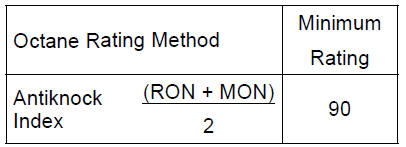

Use clean, fresh unleaded gasoline with a minimum Antiknock Index of 90.
The Antiknock Index is posted on service
station pumps. The octane rating
of a gasoline is a measure of its resistance
to detonation or “knocking.” The
Antiknock Index is an average of the
Research Octane Number (RON) and
the Motor Octane Number (MON) as
shown in the table.
NOTICE
Use minimum of 90 octane gasoline only to prevent severe engine damage.
NOTICE
If engine “knocking” or “pinging” occurs, use a different brand of gasoline of a higher octane rating. If this condition is allowed to continue it can lead to severe engine damage.
Gasoline quality is important.
Fuels of low quality or not meeting standard industry specifications may result in unsatisfactory performance. Operating problems that result from the use of poor quality or nonrecommended fuel may not be covered under your warranty.
 Fuel Tank
Fuel Tank Fuels Containing Oxygenates
Fuels Containing OxygenatesPiston Wear Inspection
Measure the outside diameter [A] of each piston 5 mm
(0.20 in.) [B] up from the bottom of the piston at a right
angle to the direction of the piston pin.
If the measurement is under service limit, replace the piston.
Piston Diameter
Standard: 75.959 75.974 mm
(2.9905 2.9911 in.)
...
Damping Force Adjustment (
ZX1000JC/KC)
To adjust the damping force, turn the damping adjuster
[A] until you feel a click.
The standard adjuster setting is the 18th click from the
1st of the fully clockwise position. If the damping feels too
soft or too stiff, adjust it in accordance with the following
table.
Damping Force Adj ...
Throttle Grip and Cables
Free Play Inspection
Refer to the Throttle Control System Inspection in the Periodic
Maintenance chapter.
Free Play Adjustment
Refer to the Throttle Control System Inspection in the Periodic
Maintenance chapter.
Cable Installation
Install the throttle cables in accordance with the Cable,
...